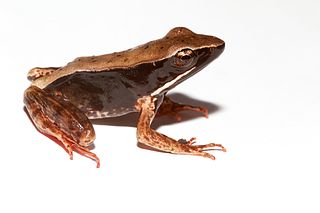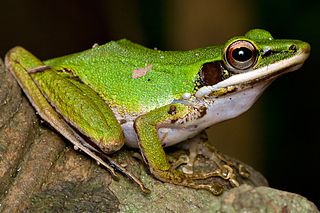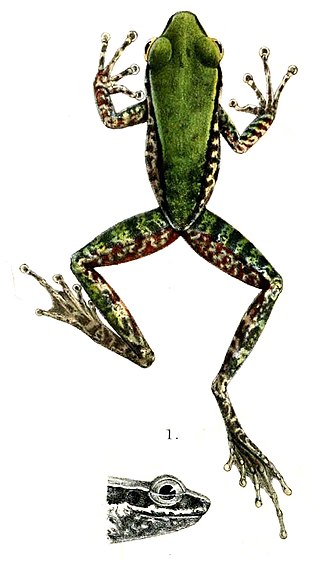
Meristogenys is a genus of true frogs from Borneo. Its tadpoles are adapted to fast-flowing mountain streams and easily recognizable by their divided upper lip with ribs on the outside.

Fejervarya limnocharis is a species of frog found in South East Asia and parts of Indochina. It is known under many common names, including Boie's wart frog, rice field frog, and Asian grass frog. Molecular studies of the species complex suggest that there may be multiple species involved.

Indosylvirana aurantiaca, commonly known as the golden frog, is a species of frog endemic to the Western Ghats of India. The species is also known as the Trivandrum frog, the common wood frog, or the small wood frog.

Hose's frog is a true frog species with a wide range in Southeast Asia. This species was named after zoologist Charles Hose.

Meristogenys jerboa is a species of frog in the family Ranidae. It is endemic to western Sarawak in Borneo. Common names western torrent frog, Matang torrent frog, and Gunther's Borneo frog have been coined for it. Many cryptic species have been separated from this species. Based on mitochondrial DNA, current "true" Meristogenys jerboa still includes two major lineages. However, because the lineages occur in sympatry and do not differ in morphology, Shimada and colleagues elected to treat them as intraspecific variants.
Meristogenys macrophthalmus is a species of frog in the family Ranidae. It is endemic to Sarawak in northern Borneo (Malaysia) and is only known from its type locality in the Bintulu District. The specific name macrophthalmus is derived from the Greek words macros (="large") and ophthalmos (="eye") and refers to the large eyes of this frog. Common names Matsui's Borneo frog, large-eyed torrent frog, and big-eyed torrent frog have been coined for it.
Meristogenys phaeomerus is a species of frog in the family Ranidae. It is endemic to Borneo and known from central Sarawak (Malaysia) and adjacent Kalimantan (Indonesia). The specific name phaeomerus is derived from the Greek phaios for "dusky" and meros for "thigh", in reference to the appearance of the rear of the thigh. Common names Kapit Borneo frog and Kapit torrent frog have been coined for it.
Meristogenys poecilus is a species of frog in the family Ranidae. It is endemic to Borneo and known from between central Sarawak (Malaysia) and central Kalimantan (Indonesia). The specific name poecilus is derived from the Greek poikolos, meaning "pied" or "blotched", in reference to diagnostic pattern on rear of the thigh. Common name Malaysian Borneo frog has been coined for this species.

Warszewitsch's frog is a species of frog in the family Ranidae found in Honduras, Nicaragua, Costa Rica, and Panama.

Chalcorana labialis, also known as the white-lipped frog, is a species of "true frog" in the family Ranidae. As currently known, it is endemic to Peninsular Malaysia, although it might also occur in Singapore. Molecular data suggest presence of three distinct lineages in the same area, one of which is not closely related to Chalcorana labialis and which could represent an unnamed species.

Chalcorana is a genus of frogs in the family Ranidae, "true frogs". They are found in Southeast Asia, from Thailand to Malay Peninsula and the Sunda Islands.
Papurana attigua is a species of frog in the family Ranidae, the "true frogs". It is found in central and south Vietnam, eastern Cambodia, and southern Laos. The specific name attigua is derived from Latin attiguus meaning "neighbor". It refers to the similarity of this species to Indosylvirana milleti. The common name similar frog has been coined for this species.
Chalcorana chalconota is a species of "true frog", family Ranidae. It is endemic to Indonesia and occurs in southern Sumatra, Java, Bali, and a few smaller islands. Populations previously assigned to this species now belong to a number of other Chalcorana species, leading to the current delineation of Chalcorana chalconota with a much narrower range. This species is also known as the Schlegel's frog, brown stream frog, copper-cheeked frog, or, among with many other species, white-lipped frog.

Chalcorana eschatia is a species of "true frog" in the family Ranidae. It is known from southern Thailand, but is likely to be more widespread. It was split off from Chalcorana chalconota by Robert Inger and colleagues in 2009, along with a number of other species in so-called "Rana chalconota group". The specific name eschatia, derived from the Greek word for "outskirt", refers to distribution of this species being at the edge of the geographical range of the group.

Chalcorana macrops is a species of "true frog" in the family Ranidae. It is endemic to Sulawesi, Indonesia. Common name Masarang frog has been coined for it. The specific name macrops refers to the large eyes of this frog.
Chalcorana mocquardi is a species of "true frogs" in the family Ranidae. It is endemic to Sulawesi, Indonesia, including some offshore islands. It is probably similar in its ecological requirements to Chalcorana chalconota and is associated with small lowland forest streams. It occurs in both primary and degraded forests, provided that a reasonably closed canopy remains. Adults disperse more widely in the forest, whereas the tadpoles live in side pools and slow-flowing, deeper sections of the streams. No significant threats to this species are known.
Chalcorana parvaccola is a species of "true frog" in the family Ranidae. It is endemic to Sumatra, Indonesia. It was split off from Chalcorana chalconota by Robert Inger and colleagues in 2009, along with a number of other species. The specific name parvaccola is derived from Latin parvus meaning small and accola meaning neighbor, and refers to this species being smaller than its "neighbor", the related Sumatran species Chalcorana rufipes.

Chalcorana raniceps, also known as the copper-cheeked frog, white-lipped frog, or Peters' Malaysian frog, is a species of "true frog" in the family Ranidae. It is endemic to Borneo, including Brunei Darussalam, Kalimantan (Indonesia), and Sarawak (Malaysia), although it is likely to occur more widely. Previously mixed with Chalcorana chalconota and believed to have much wider distribution, its range was delimited to Borneo in the revision of "Rana chalconota" complex by Robert Inger and colleagues in 2009.
Chalcorana rufipes is a species of "true frog" in the family Ranidae. It is endemic to Sumatra, Indonesia. It was split off from Chalcorana chalconota by Robert Inger and colleagues in 2009, along with a number of other species. The specific name rufipes is derived from Latin rufus meaning reddish and pes meaning foot, in reference to the reddish tinge on the underside of the pedal webbing in life.
Chalcorana scutigera is a species of "true frog" in the family Ranidae. However, it is a poorly known species that might actually be synonymous with Polypedates leucomystax. It is endemic to Peninsular Thailand. Common names Haut Sanuk frog and yellow trea frog have been coined for it.











